The Intel Core i7-7700K (91W) Review: The New Out-of-the-box Performance Champion
by Ian Cutress on January 3, 2017 12:02 PM EST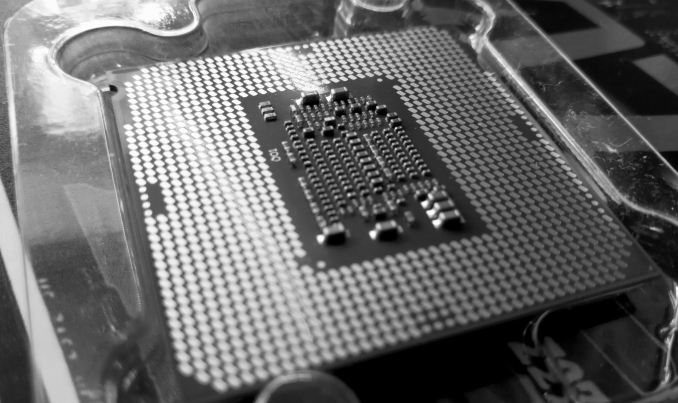
The i7-7700K, launched today, is Intel's fastest ever consumer grade processor. Using Intel’s third set of processors at 14nm, using the new 14+ variant, we get processors with a better frequency / voltage curve that translates into more performance, better efficiency, and the potential to push the silicon further and harder. Here is our review.
Meet Kaby Lake, and 4.5 GHz Out-of-the-Box
The i7-7700K is part of Intel's 7th Generation of Core CPUs, which often goes by its internal code name 'Kaby Lake'. The Kaby Lake family, as of today's launch, stretches from 91W on the mainstream desktop down to 4.5W for notebook processors, all using the same underlying technology in different core and integrated graphics configurations. The i7-7700K is the top part of this processor family, featuring four cores with hyperthreading, a 4.2 GHz base frequency, a 4.5 GHz turbo frequency, a couple of new tricks and all for $303 list (so about $330 retail).
As a processor with the letter K in it, in Intel's lingo this means the i7-7700K is an unlocked processor. Users with enough nous to understand the relationship between frequency, voltage, temperature and stability can take this processor above (or below) its standard operating frequency to get more performance without spending more money. The upshot of pushing the processor in this way is usually a higher power consumption, something that PC enthusiasts usually have to spare, and in the wrong hands a broken CPU through overclocking is worth the same as sand. There are two other K processors in the Kaby Lake family, the i5-7600K and the i3-7350K, which both have separate reviews as part of our launch coverage.
| Intel Kaby Lake S SKUs | |||||||
| Cores/ Threads |
Base/ Turbo |
IGP | L3 | eDRAM | TDP | Cost | |
| i7-7700K | 4/8 | 4.2/4.5 | HD 630 | 8 MB | - | 91 W | $305 |
| i7-7700 | 4/8 | 3.6/4.2 | HD 630 | 8 MB | - | 65 W | $272 |
| i7-7700T | 4/8 | 2.9/3.8 | HD 630 | 8 MB | - | 35 W | $272 |
| i5-7600K | 4/4 | 3.8/4.2 | HD 630 | 6 MB | - | 91 W | $217 |
| i5-7600 | 4/4 | 3.5/4.1 | HD 630 | 6 MB | - | 65 W | $199 |
| i5-7600T | 4/4 | 2.8/3.7 | HD 630 | 6 MB | - | 35 W | $199 |
| i5-7500 | 4/4 | 3.4/3.8 | HD 630 | 6 MB | - | 65 W | $179 |
| i5-7500T | 4/4 | 2.7/3.3 | HD 630 | 6 MB | - | 35 W | $179 |
| i5-7400 | 4/4 | 3.0/3.5 | HD 630 | 6 MB | - | 65 W | $170 |
| i5-7400T | 4/4 | 2.4/3.0 | HD 630 | 6 MB | - | 35 W | $170 |
| i3-7350K | 2/4 | 4.2 | HD 630 | 4 MB | - | 60 W | $157 |
| i3-7320 | 2/4 | 4.1 | HD 630 | 4 MB | - | 51 W | $139 |
| i3-7300 | 2/4 | 4.0 | HD 630 | 4 MB | - | 51 W | $129 |
| i3-7300T | 2/4 | 3.5 | HD 630 | 4 MB | - | 35 W | $129 |
| i3-7100 | 2/4 | 3.9 | HD 630 | 3 MB | - | 51 W | $109 |
| i3-7100T | 2/4 | 3.4 | HD 630 | 3 MB | - | 35 W | $109 |
Intel calls the desktop like of processors the S series, and Kaby Lake-S (or KBL-S) ranges from a dual core low power 35W i3-7100T to the high-end 91W i7-7700K. The idea here is to offer many different parts at different price points to cater for customer needs, such as performance, power, cost and feature set. With every launch Intel tries to entice users to upgrade from their older system (citing hundreds of millions of daily PCs being 3+ years old), and so having new features is key to having better performance too.
With the high-end i7-7700K, being the top processor, the main draw is typically performance and overclockability. This review aims to take us through both of these, and the reasons why.
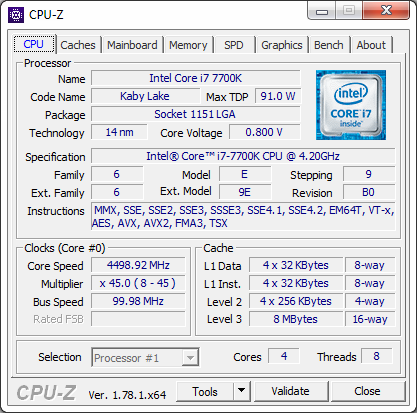
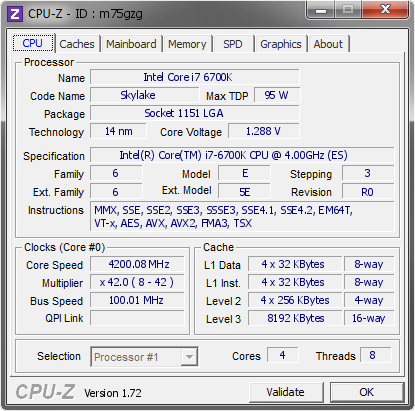
Intel Core i7-7700K (Kaby Lake) and Core i7-6700K (Skylake)
Comparing it to the previous generation high-end i7-6700K Skylake processor, we get the same configuration of cache hierarchy. The main difference between the two will be support for DDR4-2400 on the Kaby Lake rather than DDR4-2133, updated integrated graphics, a new generation of Speed Shift, AVX Offset support, and support for Intel’s ‘Optane Memory’.
Typically with each new generation of Intel CPUs brings about a fundamental increase in performance through the rate of instructions per cycle/clock (IPC) that the processor can go through. That being said, Intel has stated (and we've confirmed through testing) that Skylake and Kaby Lake are identical for IPC. As a result, the i7-7700K attempts to take the performance crown through frequency alone. The i7-6700K runs as 4.0 GHz base and 4.2 GHz turbo, while the i7-7700K runs at 4.2 GHz base and 4.5 GHz turbo. We quantify what this means in this review.
Speed Shift v2
For the i7-6700K family, Skylake, Intel introduced Speed Shift (v1). This was a feature that, at a high level, gave control of the voltage/frequency curve from the operating system to the processor. Using a series of internal metrics, such as instruction analysis and frequency, the CPU would automatically adjust the voltage and frequency of the processor as required. This afforded two major benefits: one, with the CPU in control it has access to many more points on the curve compared to the OS which is limited to specific P-states on the processor.
The second benefit is the speed of transition. A processor that can ramp up to a high frequency quickly and then drop down as needed can get through instructions quicker but also save power. Imagine driving a car, and having to wait 60 seconds to change a gear – it’s that sort of analogy.
What Speed Shift v2 does in the i7-7700K and the Kaby Lake family, compared to v1 in Skylake, is manage those transitions to higher frequency faster. Before Speed Shift, transitions from idle to peak turbo were on the order of 100 milliseconds, and Speed Shift v1 took that to 30 milliseconds (with a good base established within 15). Speed Shift v2 means that peak performance from idle now happens in 10-15 milliseconds total. This means that interactions with the OS, such as touch, or actions that rely on low latency, can occur within a couple of frames on a 60 Hz display.
The benefit of Speed Shift lies a lot in touch devices, which perhaps doesn’t affect the i7-7700K in this review, but also in web interactions. A lot of web work is stop and start, such as scrolling or javascript functions.
There is one caveat however – Speed Shift currently only works in Windows 10. It requires a driver which is automatically in the OS (v2 doesn’t need a new driver, it’s more a hardware update), but this limitation does mean that Linux and macOS do not benefit from it. I would be hard pressed to not imagine that Apple and Intel were not working on a macOS driver, but as yet we have not had confirmation that one exists.
Optane Memory Support
The latest memory technology to hit prime time is Intel and Micron’s 3D XPoint. This is a non-volatile form of data storage that is bit addressable and can be used as DRAM or storage. Despite being at least a decade in the making, and being formally announced in 2014, it is still yet to show up commercially as it is still being developed. Intel plans to create 3D XPoint DRAM that is slightly slower than normal DRAM but both denser (more of it) and non-volatile (keeps the data after power loss, saves power altogether), as well as 3D XPoint Storage that is faster than standard NAND flash, and more configurable. It the scheme of things, we expect the storage based products to hit the market first.
Intel, as far as we can tell, is set to release two main classes of product: Optane DRAM to be pin-compatible with DDR4 and require Optane DRAM enabled processors, and Optane SSDs which should work with any PCIe storage interface. ‘Optane Memory’ however, is something a little different. Based on pre-briefings, Optane Memory is certainly not Optane SSD we were told, but rather a storage cache for mechanical hard-drives. We’ve had this before with NAND flash drives, using Intel’s Rapid Storage Technology, and it seems that Kaby Lake and 200-series chipsets will support a new version of RST for PCIe-based storage. But because this is caching drive, such as the 16GB Optane Memory drives in Lenovo’s upcoming notebooks, and not Optane SSD, might lead us to believe that ‘Optane Memory’ drives are not designed to be directly user addressable.
All that being said, Intel has stated that Optane Memory standalone drives should hit the market nearer Q3 for general consumer use, which is more in-line with what we might expect to see with Optane SSDs in the enterprise space.
More about Kaby Lake
For readers that want a more in-depth take on Kaby Lake as a platform, we have a dedicated article full of information for you. We also have other articles in our Kaby Lake bonanza for launch day.
Other articles include:
Intel Launches 7th Generation Kaby Lake (Overview and Core Improvements)
The Intel Core i7-7700K Review: The New Out-of-the-box Performance Champion
The Intel Core i5-7600K Review: The More Amenable Mainstream Performer
The Intel Core i3-7350K Review: When a Core i3 Nearly Matches the Core i7-2600K
Upcoming (we’re at CES and didn’t have time to finish these yet):
Calculating Generational IPC Changes from Sandy Bridge to Kaby Lake
Intel Core i7-7700K, i5-7600K and i3-7350K Overclocking: Hitting 5.0 GHz on AIR
Intel Launches 200-Series Chipset Breakdown: Z270, H270, B250, Q250, C232
Intel Z270 Motherboard Preview: A Quick Look at 80+ Motherboards




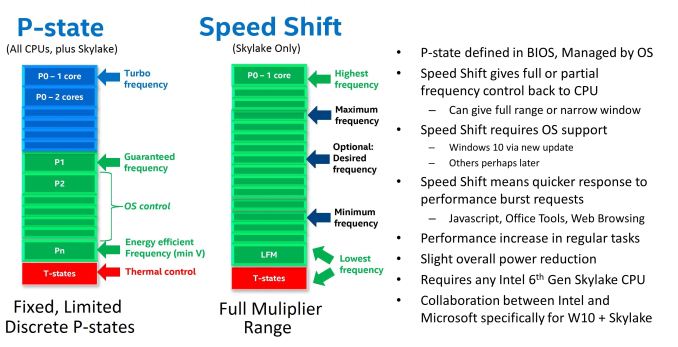
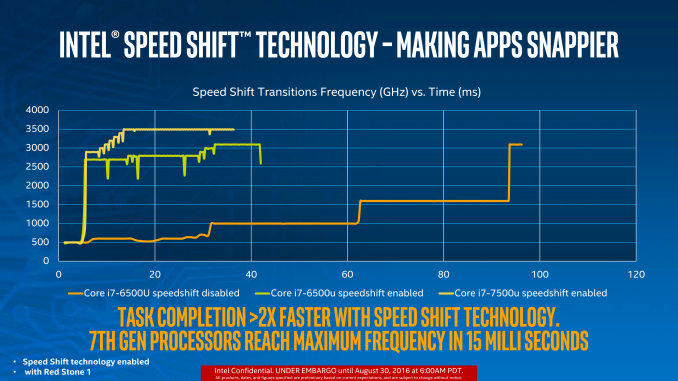









125 Comments
View All Comments
silverblue - Wednesday, January 4, 2017 - link
To be fair, even if Intel can't go any further with IPC on this architecture, extra clock speed for no extra power isn't such a bad thing. This was the optimisation step of the cadence anyway, so I don't get the hate.Lolimaster - Wednesday, January 4, 2017 - link
Normally the chips should be called 6780K or 6790K, intel forgot that you can increase the SKU number when models with higher clocks appears.Now it's the "new 7th gen".
silverblue - Thursday, January 5, 2017 - link
I agree about the naming, though perhaps they just wanted to set their newer models apart. A 6710K (or, indeed, a 6780K) wouldn't confuse most of us.Manch - Thursday, January 5, 2017 - link
Its basically the same as NVidia and AMD rebadging GPU's. Now Intel is doing the same thing.silverblue - Thursday, January 5, 2017 - link
A true rebrand would do little if nothing at all for a higher number; Intel have at least made tweaks.fanofanand - Thursday, January 26, 2017 - link
Not true, with nearly every re-badge they have either increased VRAM capacity or speed, and/or increased clocks on the shaders. Re-badges suck but they have almost always offered at least tiny improvements, much like Kaby Lake.Thatguy97 - Friday, January 6, 2017 - link
The hate is that this is a complacent IntelLolimaster - Wednesday, January 4, 2017 - link
There's 0.00% IPC improvement.tvdang7 - Wednesday, January 4, 2017 - link
Why didn't you compare the performance gap between generations like you guys do for the other reviews.lopri - Wednesday, January 4, 2017 - link
AVX Offset? Why isn't that a cheat?